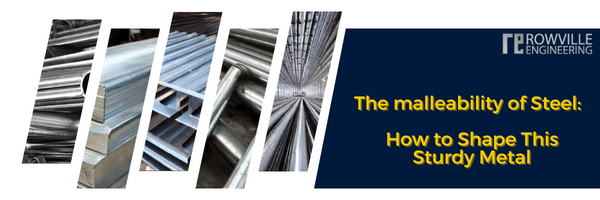The malleability of Steel: How to Shape This Sturdy Metal
Steel is generally considered to be one of the strongest metals, but it’s also malleable, meaning it can be bent and shaped into new forms easily. In fact, an untrained individual can bend a steel rod over their knee because it’s so malleable! That said, bending steel requires specific knowledge and tools – if you don’t know what you’re doing, you can end up damaging your project instead of completing it properly. Here’s how to shape and form steel using the least-expensive tools possible.
Published On:06-02-2023

What is malleability?
Steel is a common construction material that is strong and sturdy. It is used to construct buildings, bridges, and aeroplanes. With such a wide range of uses for steel, it needs to be malleable so it can be shaped into the desired object. To make steel malleable, carbon is added. When heated up at high temperatures in an oven or furnace, the carbon bonds with the steel molecules and makes them more pliable so they can be moulded into different shapes. The longer the steel stays in this heated state (or heat treatment), the more flexible it becomes. There are two different types of carbon steels which are categorized by how much carbon has been added during manufacture--low-carbon and high-carbon steels.
The benefits of malleability
Steel has a wide range of properties that make it an excellent material for construction. For example, it is a sturdy metal that can be formed into many different shapes while also being lightweight and durable. Its malleability makes the steel very versatile, as well as easy to work with. In addition, steel is recyclable, which means that if the need arises, you can melt down old pieces of steel and use them in new projects.
The disadvantages of malleability
This metal is very malleable, meaning that it can be shaped into many different things without breaking. While this is great for some purposes, when it comes to structural integrity and durability, steel can't compete with other types of metals. It has a low melting point which means that it can be easily melted down and reused as well as rendered useless by water or other liquids. Steel is also not able to withstand much wear and tear before it will start to rust. Other metals such as iron are more durable than steel because they are less malleable, meaning they cannot be shaped the way steel can but are able to withstand more wear and tear before becoming too damaged.
The best way to shape steel
Shaping steel is a process that requires patience and skill, as it is one of the most durable metals around. Steel is highly malleable, meaning it can be manipulated and molded into many different shapes and forms. There are several different methods for shaping steel, each with their own advantages and disadvantages.
One popular method for shaping steel is through the use of press brakes. A press brake uses a combination of pressure and bending tools to shape steel into the desired shape. This process is great for intricate shapes and curves, but can take longer than other methods due to the need for careful adjustments.
Another method of shaping steel is through the use of a drop hammer. A drop hammer uses a large force to quickly shape metal into the desired shape. This method is best used for simple shapes and basic forming, as it does not require precise control as press brakes do.
Finally, there is the process of heat treatment. Heat treating involves heating the steel to a specific temperature and then cooling it slowly. This process can help improve steel's strength, durability, and ductility. It is often used when creating parts that need to withstand high levels of stress or pressure, such as those found in automotive engines and other machines.
No matter which method you choose, it's important to know that properly shaping steel requires knowledge and skill. When done correctly, however, you can achieve amazing results that can last a lifetime. With some practice and patience, anyone can learn how to shape steel into beautiful works of art.
The different types of steel
Steel is a widely used material, known for its strength and malleability. It has many different varieties that each has its own unique characteristics and uses. In this article, we'll explore the various types of steel and how they can be shaped and moulded.
First, let's start with carbon steel. Carbon steel is an alloy made by combining iron and carbon. It is one of the most commonly used types of steel due to its malleability, strength, and affordability. Carbon steel can be welded, bent, or formed into virtually any shape. It is often used in construction, automotive manufacturing, and even aerospace applications.
Next, we have stainless steel. Stainless steel is an alloy made from combining iron, chromium, and nickel. It is corrosion-resistant and highly durable, making it great for outdoor applications such as outdoor furniture, fences, and architectural cladding. It is also extremely easy to shape and form due to its malleability, making it a popular choice for kitchen equipment and tools.
Finally, there is a tool steel. Tool steel is an alloy made by combining iron and other elements such as manganese and molybdenum. It is extremely hard and resistant to wear and tear, making it ideal for use in industrial applications where high levels of durability are required. Tool steel is often used in the creation of industrial cutting tools such as drill bits, saw blades, and chisels.
In conclusion, steel is a highly malleable material that can be shaped and moulded into a wide variety of shapes and sizes. From carbon steel for construction purposes to stainless steel for kitchen equipment, many different types of steel are available to meet any need. Steel has you covered if you need a strong and durable material for industrial applications or something more malleable for crafting projects!